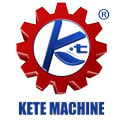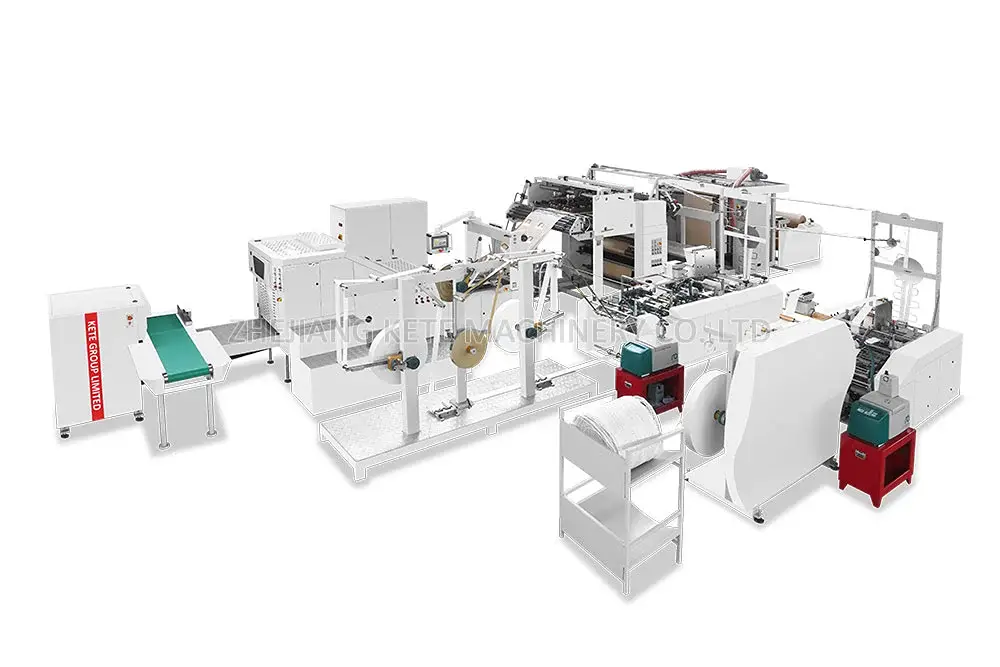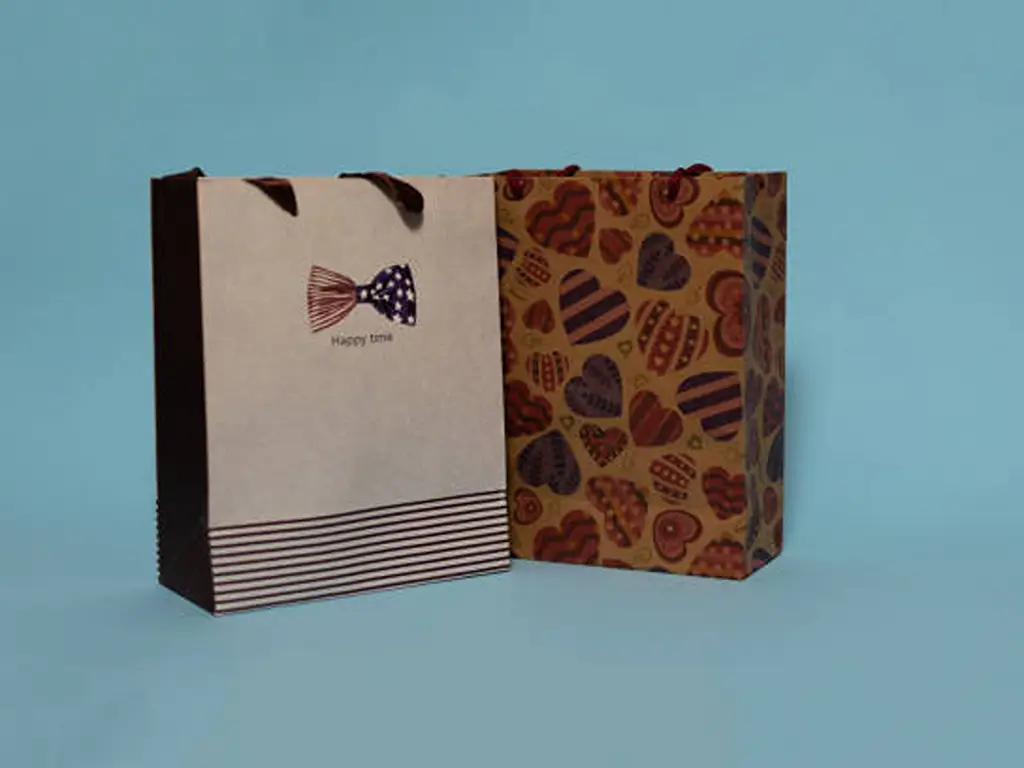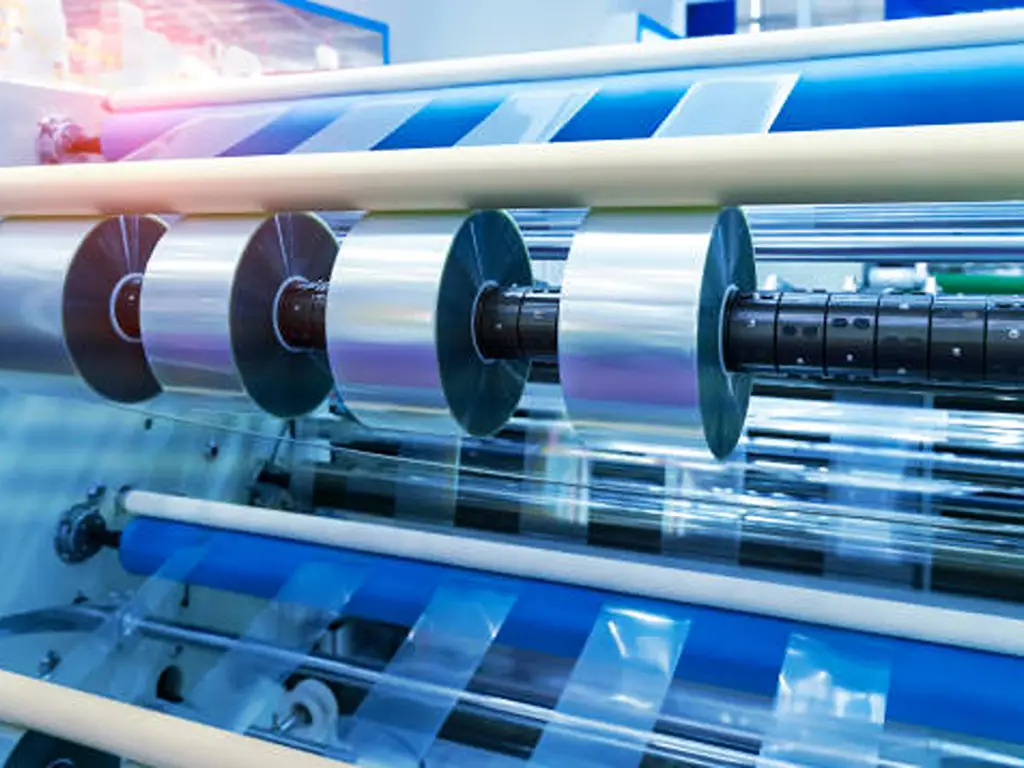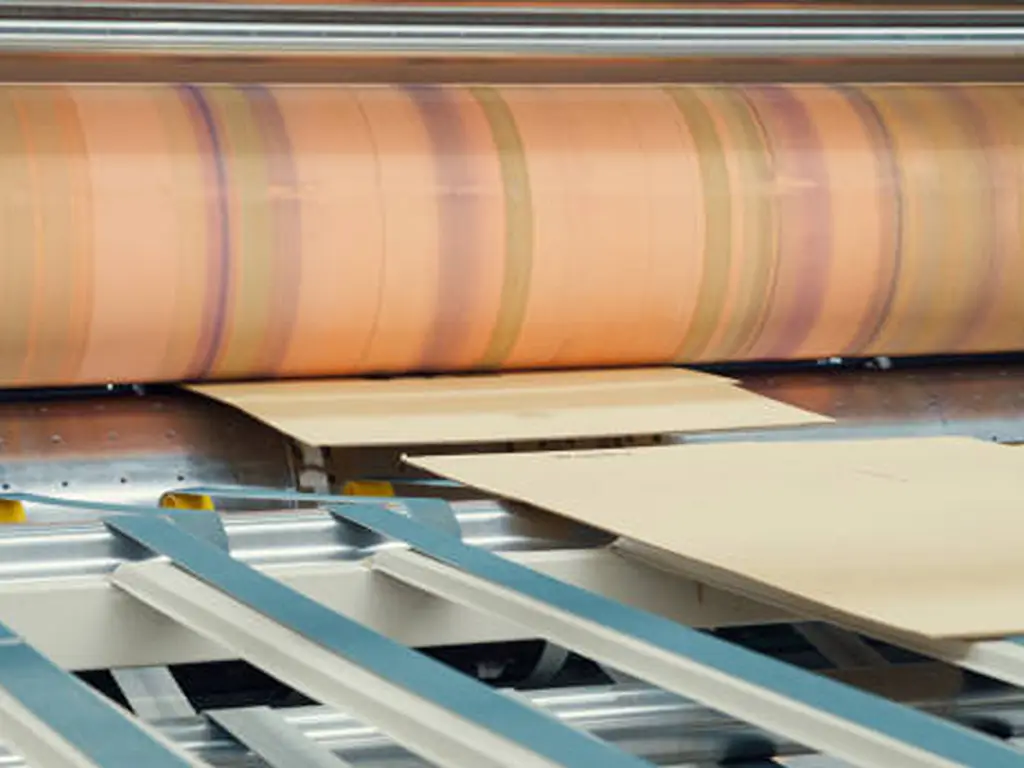In the modern competitive world of Industry, more so in the flexible packaging industry and material processing domains, running an enterprise hinges on how accurate and efficient it is. The efficiency with which a plastic film slitter or other film slitting machine can convert wide rolls into more narrowly sized rolls has an effect on one’s production costs, product quality and competitive position in the market. Making these selections may not simply be a matter of purchasing the equipment; It is a decision of utmost strategic value for your company’s expansion efforts. In simpler terms, it’s as if you are placing a powerful “heart” into your production line.
Why Choosing the Right Slitting Machine Matters?

Picture what challenges you will encounter using equipment that does not fit your needs best. Production-low efficiency might create bottlenecks, unstable operation may lead to high reject rates, and delivery schedules could also be at risk. The costs are rising, and, moreover, customer trust gets wasted. An appropriate slitting machine allows producing needed rolls with smooth edges and tight, uniform winding which greatly enhances production efficiency, reduces waste, and increases competitiveness on the market. It directly translates into best value packaging and other assets for customers.
Common Types of Slitter for Film Slitting
The categorization of slitting machines comes from the arrangement of their winding and unwinding systems which greatly affects their productivity and appropriateness for different volumes and types of goods.
- Simplex Slitter: These machines possess a single rewind shaft which serves as a winding core. The system halts following a winding cycle so that the operator can remove the finished rolls and place new cores. Simplex slitters are a little more affordable due to their simpler construction, which makes them appropriate for lower production volumes or in cases where downtime while unloading is permissible.
- Duplex Slitter: These have two rewind shafts, thus allowing for continuous slitting and rewind. While one shaft winds a set of finished rolls, the other will be prepared for the next set. After completion of the first set, the web transfer to the second shaft occurs with minimal delay. This increases efficiency significantly, making this design suitable for medium to high production volumes.
- Turret Slitter: Turret slitters are the most automated and efficient in this category. They usually have two sets of duplex rewind shafts mounted on a rotating turret. This enables finished rolls to be automatically severed and hitched onto the next pair of cores on the turret while the machine operates at maximum speed. This reduces the downtime between sets of rolls, which is crucial when producing very large quantities of thinner rolls.
Suitable Materials and Applications for Film Slitters
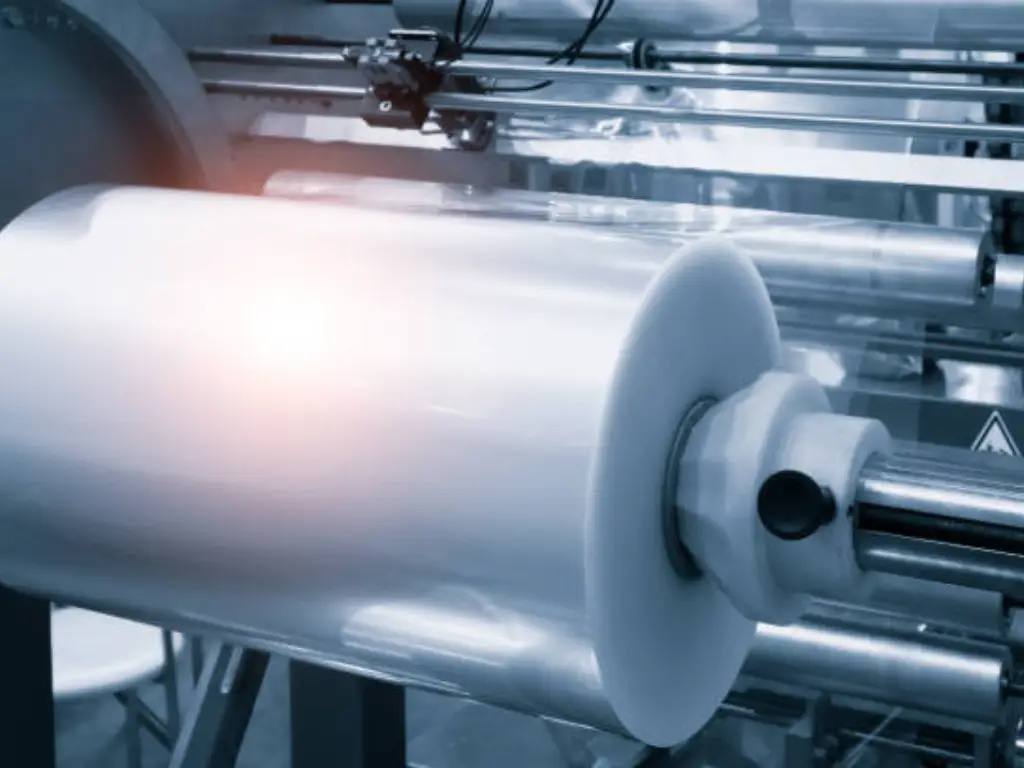
Film slitting machines find applications in almost every industry that converts flexible roll materials into narrower strips. Examples of such materials include, but are not limited to:
- Various Plastic Films: PET, BOPP, CPP, PE, PVC Film, PI, PVA, PTFE, etc., widely used in electronics, optics, protection, insulation, and other fields.
- Paper: Various packaging papers, specialty papers, release liners, self-adhesive paper, etc.
- Metal Foils: Aluminum foil, copper foil, etc.
- Non-woven Fabrics: Non-woven materials for medical, hygiene, and packaging uses.
- Laminates / Composite Materials: Food packaging laminates, industrial laminates, etc.
- Label Stock: Self-adhesive label rolls.
These machines’ end products serve numerous industries:
- Packaging: Flexible packaging, labels, tapes, cartons, etc.
- Printing: Processing roll materials after printing for subsequent converting or bag making.
- Labeling: Slitting self-adhesive materials for producing various label rolls.
- Tape Manufacturing: Slitting jumbo rolls of various tapes.
- Electronics: Optical films, battery separators, release films, and other precision materials.
- Hygiene Products: Processing non-woven fabrics and film materials.
- Industrial: Protective films, adhesive tapes, building materials, etc.
Regardless of whether you deal with flexible packaging materials or are an end-user in the food & beverage, beauty and personal care, industrial manufacturing, or even logistics, the sharpness and consistency of your packaging solutions depend on a high-performance slitting machine.
How to Choose Your Film Slitting Machine?
Choosing the best slitting machine for your production processes requires close attention to detail, as well as specialist knowledge. These are the most important evaluation criteria:
Assess Your Material Needs
Initially, specify the kinds of materials you predominantly need to work with. Are they sheets or films? Are they single-layer or composite materials? Factors like material thickness, width, flexibility, and surface properties such as static cling or smoothness will all impact the machine setup. Handling ultra-thin films or high-stretch materials require advanced tension control and static control systems.
Determine Production Volume Requirements
What is your target annual or shift production output? This directly dictates the machine speed and level of automation you need. If you need to process large rolls, you will require machines with larger unwind diameters and higher speeds. Clear production goals will help you narrow down the models that meet your efficiency requirements.
Define Quality Standards
What are your specific requirements for the quality of the finished rolls? Do the slit edges need to be perfectly smooth without burrs or fraying? Does the winding tightness of the finished rolls need to be highly uniform to avoid telescoping or dishing? These requirements determine the necessary precision control systems on the machine, such as high-accuracy tension control, edge guiding systems (EPC), and the appropriate rewind shaft type (e.g., differential shafts are advantageous for materials with tension variations across the web, while air shafts are versatile).
Consider Your Budget
A budget is perhaps the most important detail when actually making a decision. In addition to the first purchase cost, a budget should also account for routine operational expenditures, maintenance and servicing costs, energy bills, as well as the return on investment from increased productivity and minimized waste. While the purchase price for a high-quality machine may be steep originally, the reduced long-term costs over time will prove to be extremely beneficial.
Automatisierungsgrad auswerten
What level of automation do you require? From manual loading/unloading to fully automatic loading, splicing, tension control, and robotic roll handling, different levels of automation involve different investments and labor costs. A higher level of automation generally means higher efficiency and fewer operational errors, leading to smoother production.
Exploring High-Quality Film Slitting Machine Models
With that selection criteria in mind, below are some of the most reputable film slitter rewinder machines on the market. Each model has specific advantages that deal with particular problems in production and assist you in achieving optimum production efficiency.
KETE KTSM-C600G Series

The Powerful Tamer of Jumbo Paper Rolls—KETE KTSM-C600G Series. For companies looking for breakthrough productivity, this powerful slitter rewinder is perfect for processing extra large paper rolls. With a super high speed of 600m/min and super large unwind/rewind diameters of Φ1600mm/Φ1300mm, it converts jumbo rolls into high precision finished rolls effortlessly. You will be way ahead in the paper slitting competition. Every roll benefits from rotary shear cut precision as well as stable air shaft rewinding, which assures quality standard compliance. K620CG gives the flexibility to control ultra-high output and seize an opportunity in the market.
| Technische Daten der Maschine | Model KTSM-C600G/1800 | Model KTSM-C600G/2600 |
| Struktur der Rückspulung | Duplex-Rückspulung | Duplex-Rückspulung |
| Max. Breite des Rohmaterials | 1800 mm (71 Zoll) | 2600mm (102.4”) |
| Max. Abwickeldurchmesser | Φ1600mm (63") | Φ1600mm (63") |
| Max. Aufwickel-Durchmesser | Φ1300mm (51,2") | Φ1300mm (51,2") |
| Min. Schlitzbreite | 30mm (1.18") | 30mm (1.18") |
| Max. Mechanische Geschwindigkeit | 600m/min | 600m/min |
| Papierkern Innendurchmesser | 76mm/152mm (3"/6") | 76mm/152mm (3"/6") |
| Schlitztechniken | Rotationsscherenschnitt (pneumatisch) | Rotationsscherenschnitt (pneumatisch) |
| Entfernen der Trimmung | Trimm-Sauggebläse | Trimm-Sauggebläse |
| Luftzufuhr | 0,6-0,8 Mpa (0,8m³/min) | 0,6-0,8 Mpa (0,8m³/min) |
| Gesamtleistung | 95kw | 95kw |
| Maschine Gewicht | 12000kg | 12000kg |
| Machine Size (LWH) m | 6150x4600x2300mm | 6150x4600x2300mm |
| Maschinenleistung | 5Linien 3 Phase 220/380/440V 50/60HZ | 5Linien 3 Phase 220/380/440V 50/60HZ |
KETE KTSM-C600 Series
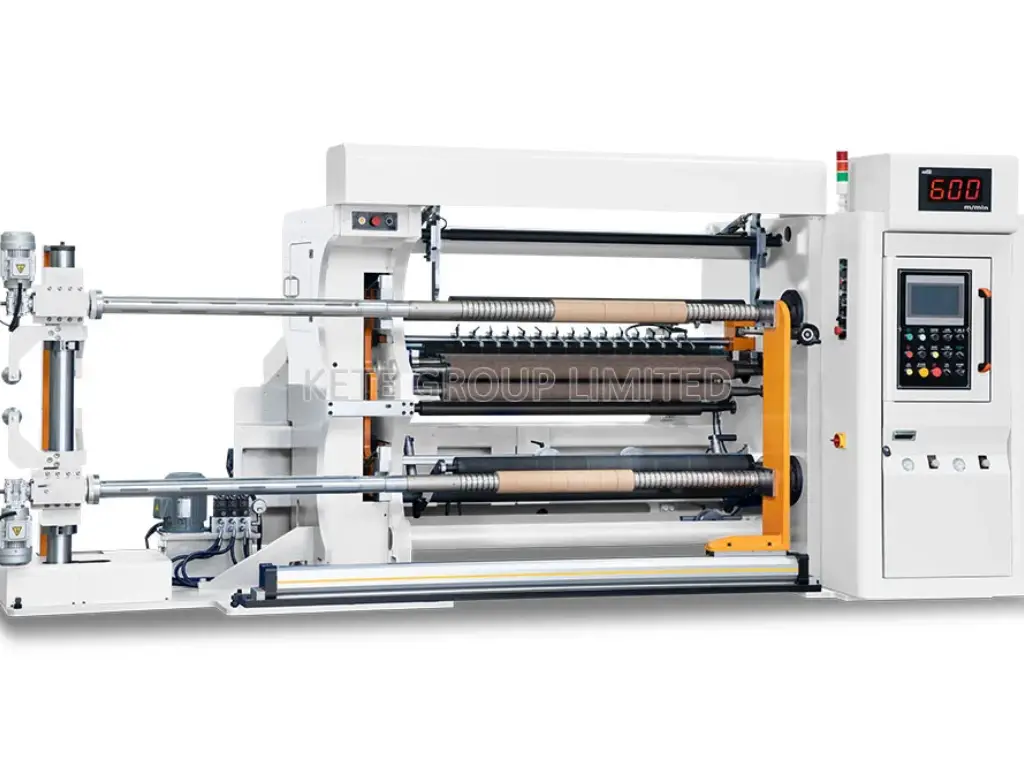
The High-Speed Engine for Flexible Packaging Slitting—KETE KTSM-C600 Series. It is an agile high-speed slitter for many flexible plastic film roll materials such as PET, BOPP, CPP, and some papers. Standard roll diameters of Φ600mm unwind and Φ450mm rewind equip the machine with blazing performance of 600 m/min, thus doubling production efficiency. Finished rolls are produced through precise razor cutting and intelligent differential shaft rewinding which guarantees perfectly smooth edges with tight and uniform winding. The C600 Series achieves high-volume, flexible slitting and high-quality efficiency.
| Technische Daten der Maschine | Model KTSM-C600/ 1100 | Model KTSM-C600/ 1300 |
| Struktur der Rückspulung | Duplex-Rückspulung | Duplex-Rückspulung |
| Max. Breite des Rohmaterials | 1000mm (39.4") | 1200mm (47.2") |
| Max. Abwickeldurchmesser | Φ600mm (23,6") | Φ600mm (23,6") |
| Max. Aufwickel-Durchmesser | Φ450mm (17,7") | Φ450mm (17,7") |
| Min. Schlitzbreite | 50mm (1.97") | 50mm (1.97") |
| Max. Mechanische Geschwindigkeit | 600m/min | 600m/min |
| Papierkern Innendurchmesser | 76mm/152mm (3"/6") | 76mm/152mm (3"/6") |
| Schlitztechniken | Rasierklinge in der Luft | Rasierklinge in der Luft |
| Entfernen der Trimmung | Gebläse | Gebläse |
| Luftzufuhr | 0,6-0,8 Mpa (0,8m³/min) | 0,6-0,8 Mpa (0,8m³/min) |
| Gesamtleistung | 25kw | 28kw |
| Maschine Gewicht | 4500kg | 5000kg |
| Größe der Maschine (LWH) | 2500x4000x2200mm | 2800x4300x2200mm |
| Maschinenleistung | 5Linien 3 Phase 220/380/440V 50/60HZ | 5Linien 3 Phase 220/380/440V 50/60HZ |
KETE KTSM-C400L Series
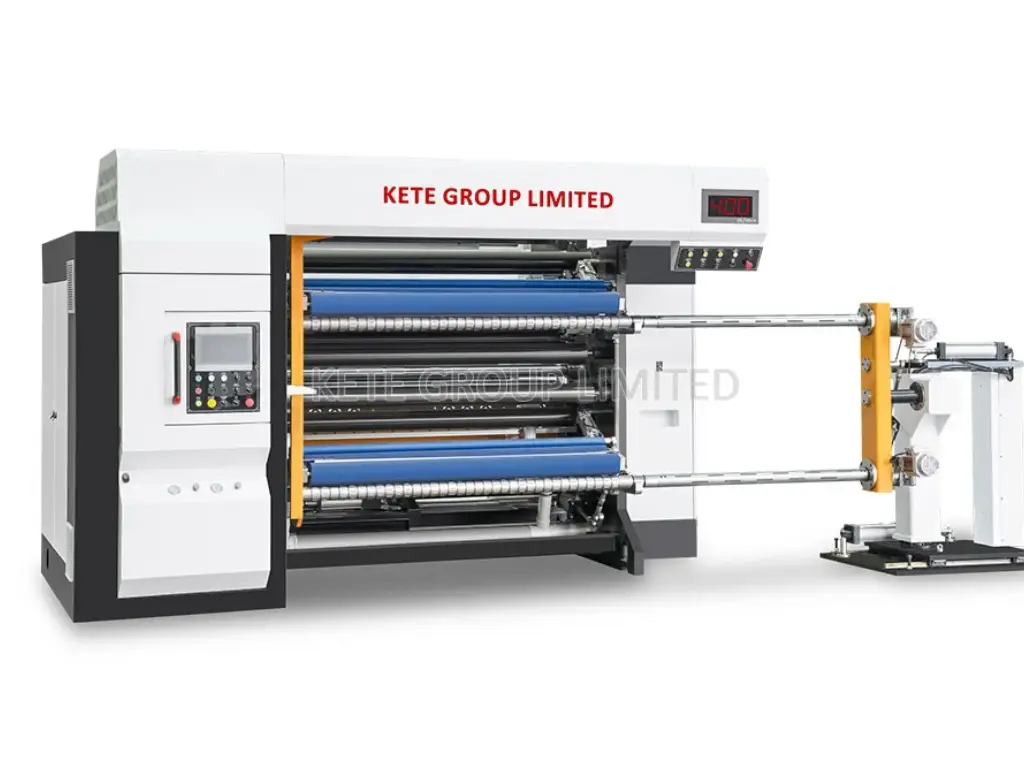
The Key to Expanding Your Product Capabilities—KETE KTSM-C400L Series. If you are looking for unwind and finished roll processing that requires flexible materials to be unwound from large finished rolls with diameters scaling up to Φ800 mm, then this machine is perfect for you as it handles unwind rolls up to Φ1800 mm and can efficiently rewind finished rolls at 400m/min ensuring a steady speed. The need for versatile, high value flexible material applications with large finished roll diameters drives the need for rotary shear cutting accuracy with precise differential shaft control. The KTSM-C400L expands your product lines and fulfills niche market demands while maintaining outstanding quality assurance even at large diameters.
| Technische Daten der Maschine | Model KTSM-C400L/ 1300 | Model KTSM-C400L/ 1700 |
| Struktur der Rückspulung | Duplex-Rückspulung | Duplex-Rückspulung |
| Max. Breite des Rohmaterials | 1200mm (47.2") | 1600mm (63") |
| Max. Abwickeldurchmesser | Φ1800mm (70.8") | Φ1800mm (70.8") |
| Max. Aufwickel-Durchmesser | Φ800mm (31,5") | Φ800mm (31,5") |
| Min. Schlitzbreite | 30mm (1.18") | 30mm (1.18") |
| Max. Mechanische Geschwindigkeit | 400m/min | 400m/min |
| Papierkern Innendurchmesser | 76mm/152mm (3"/6") | 76mm/152mm (3"/6") |
| Schlitztechniken | Rotationsscherenschnitt | Rotationsscherenschnitt |
| Entfernen der Trimmung | Gebläse | Gebläse |
| Luftzufuhr | 0,6-0,8 Mpa (0,8m³/min) | 0,6-0,8 Mpa (0,8m³/min) |
| Gesamtleistung | 12kw | 15kw |
| Maschine Gewicht | 3800kg | 4000kg |
| Größe der Maschine (LWH) | 2200x4000x2100mm | 2200x4300x2100mm |
| Maschinenleistung | 5Linien 3 Phase 220/380/440V 50/60HZ | 5Linien 3 Phase 220/380/440V 50/60HZ |
KETE KTSM-C400 Series
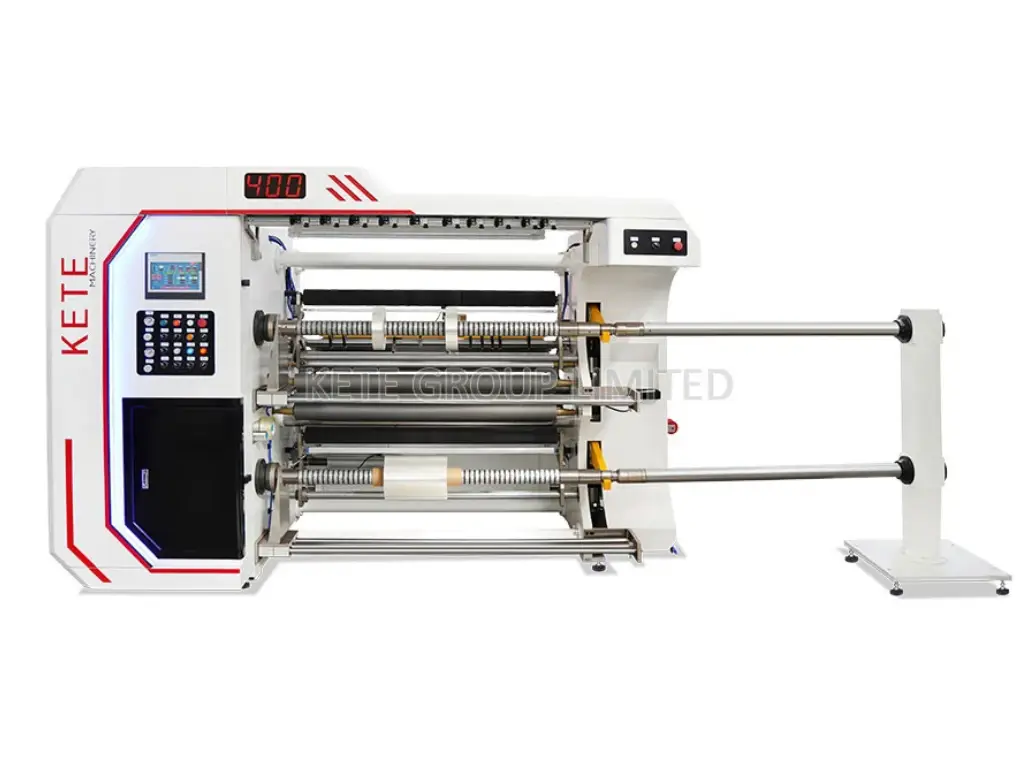
Your Reliable General-Purpose High-Speed Partner—KETE KTSM-C400 Series. For companies wanting to achieve a reasonable value for their investment alongside consistent processing of diverse flexible packaging materials, the KTSM-C400 Series makes for an outstanding consideration. It provides high-speed performance of 400m/min and standard roll diameters are easily managed (Φ600mm unwind, Φ450mm rewind). With the use of precise differential shaft rewinding coupled with effective razor cutting, stable and high-quality output production is guaranteed. By opting for the C400 Series, companies obtain a competitive, versatile, and efficient slitting solution.
| Technische Daten der Maschine | Model KTSM-C400/ 1100 | Model KTSM-C400/ 1300 |
| Struktur der Rückspulung | Duplex-Rückspulung | Duplex-Rückspulung |
| Max. Breite des Rohmaterials | 1000mm (39.4") | 1200mm (47.2") |
| Max. Abwickeldurchmesser | Φ600mm (23,6") | Φ600mm (23,6") |
| Max. Aufwickel-Durchmesser | Φ450mm (17,7") | Φ450mm (17,7") |
| Min. Schlitzbreite | 50mm (1.97") | 50mm (1.97") |
| Max. Mechanische Geschwindigkeit | 400m/min | 400m/min |
| Papierkern Innendurchmesser | 76mm/152mm (3"/6") | 76mm/152mm (3"/6") |
| Schlitztechniken | Rasierklinge in der Luft | Rasierklinge in der Luft |
| Entfernen der Trimmung | Gebläse | Gebläse |
| Luftzufuhr | 0,6-0,8 Mpa (0,8m³/min) | 0,6-0,8 Mpa (0,8m³/min) |
| Gesamtleistung | 12kw | 15kw |
| Maschine Gewicht | 3800kg | 4000kg |
| Größe der Maschine (LWH) | 2200x4000x2100mm | 2200x4300x2100mm |
| Maschinenleistung | 5Linien 3 Phase 220/380/440V 50/60HZ | 5Linien 3 Phase 220/380/440V 50/60HZ |
KETE KTSM-C350P Series
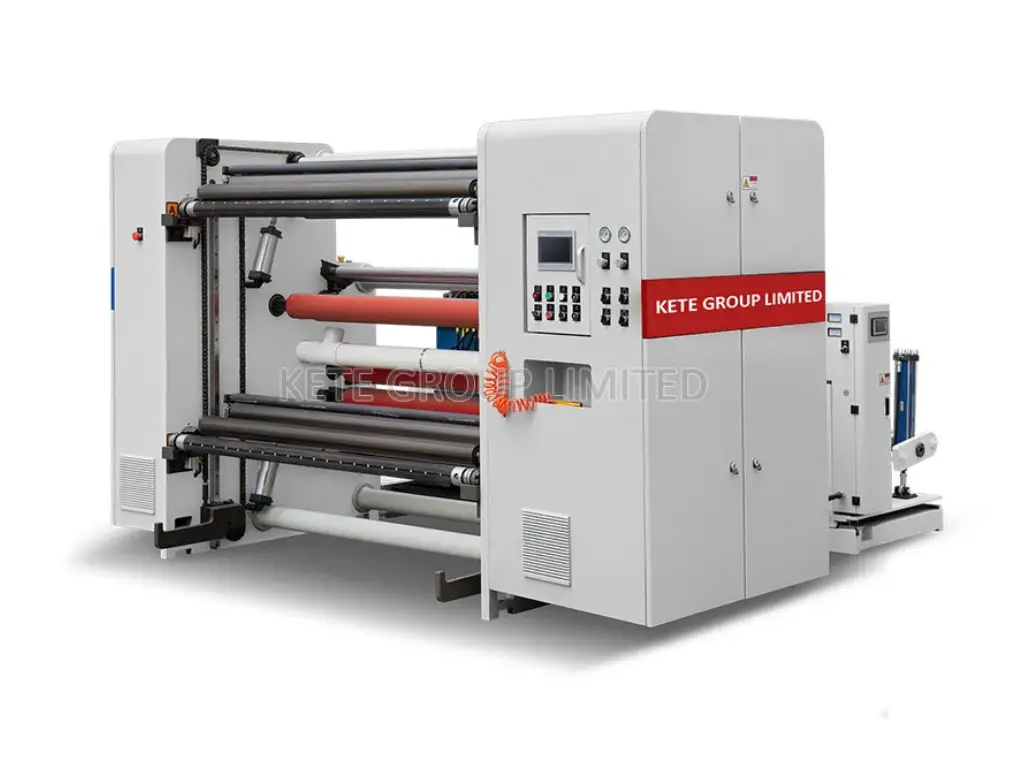
Fearless Conqueror of Complex Materials, Reliable Safeguard for Jumbo Finished Rolls—KETE KTSM-C350P Series. The KTSM-C350P fully automatic slitter is unparalleled in material compatibility as a champion of versatility, slicing and dicing tough web materials such as adhesive stickers, laminates, paper and films flawlessly. Featuring precision rotary shear cutting at 350m/min and steady air shaft rewinding, the KTSM-C350P delivers seamless flexibility and exceptional reliability even under demanding conditions. Moreover, it processes jumbo unwind rolls of Φ1200mm, yielding remarkable finished rolls of Φ1000mm in extreme dimensions, sustaining large diameter requirements.
| Technische Daten der Maschine | Model KTSM-C350P/ 1300 | Model KTSM-C350P/ 1600 |
| Struktur der Rückspulung | Duplex-Rückspulung | Duplex-Rückspulung |
| Max. Breite des Rohmaterials | 1200mm (47.2") | 1500mm (59") |
| Max. Abwickeldurchmesser | Φ1200mm (47,2") | Φ1200mm (47,2") |
| Max. Aufwickel-Durchmesser | Φ1000mm (39,4") | Φ1000mm (39,4") |
| Min. Schlitzbreite | 50mm (1.97") | 50mm (1.97") |
| Max. Mechanische Geschwindigkeit | 350m/min | 350m/min |
| Papierkern Innendurchmesser | 76mm/152mm (3"/6") | 76mm/152mm (3"/6") |
| Schlitztechniken | Rotationsscherenschnitt | Rotationsscherenschnitt |
| Entfernen der Trimmung | Gebläse | Gebläse |
| Luftzufuhr | 0,6-0,8 Mpa (0,8m³/min) | 0,6-0,8 Mpa (0,8m³/min) |
| Gesamtleistung | 18kw | 22kw |
| Maschine Gewicht | 4200kg | 5200kg |
| Größe der Maschine (LWH) | 4500x3000x1900mm | 4500x3300x1900mm |
| Maschinenleistung | 5Linien 3 Phase 220/380/440V 50/60HZ | 5Linien 3 Phase 220/380/440V 50/60HZ |
KETE KTSM-C300 Series
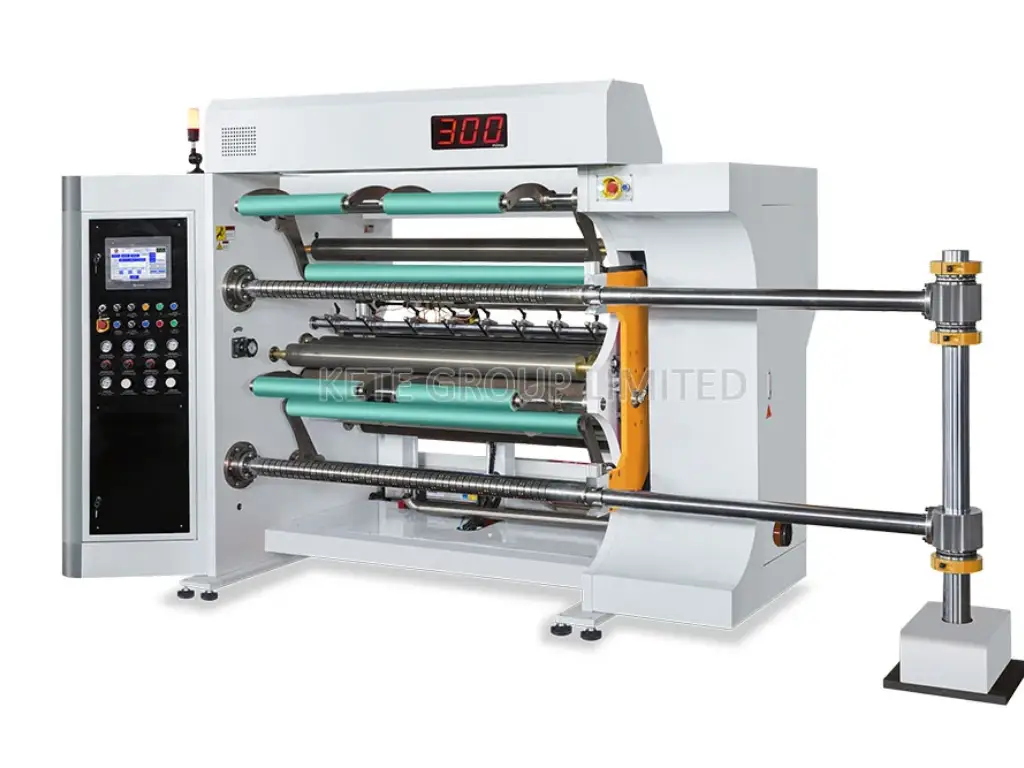
The Ideal Starting Point for Efficient Slitting—KETE KTSM-C300 Series. For those considering an upgrade to high-speed slitting machine or require a speed of 300m/min, the KTSM-C300 Series presents an economically attractive entry-level solution. It specializes in the processing of flexible packages. Its standard maximum roll diameters are Φ600mm for unwind and Φ450mm for rewind. It utilizes proven razor blade slitting and controlled differential shaft rewind systems which provide economical, high-quality slitting. This will enable you to make an intelligent initial investment towards realizing a more efficient production boost.
| Technische Daten der Maschine | Model KTSM-C300/ 1100 | Model KTSM-C300/ 1300 |
| Struktur der Rückspulung | Duplex-Rückspulung | Duplex-Rückspulung |
| Max. Breite des Rohmaterials | 1000mm (39.4") | 1200mm (47.2") |
| Max. Abwickeldurchmesser | Φ600mm (23,6") | Φ600mm (23,6") |
| Max. Aufwickel-Durchmesser | Φ450mm (17,7") | Φ450mm (17,7") |
| Min. Schlitzbreite | 50mm (1.97") | 50mm (1.97") |
| Max. Mechanische Geschwindigkeit | 300m/min | 300m/min |
| Papierkern Innendurchmesser | 76mm/152mm (3"/6") | 76mm/152mm (3"/6") |
| Schlitztechniken | Rasierklinge in der Luft | Rasierklinge in der Luft |
| Entfernen der Trimmung | Gebläse | Gebläse |
| Luftzufuhr | 0,6-0,8 Mpa (0,8m³/min) | 0,6-0,8 Mpa (0,8m³/min) |
| Gesamtleistung | 12kw | 15kw |
| Maschine Gewicht | 3800kg | 4000kg |
| Größe der Maschine (LWH) | 2200x4000x2100mm | 2200x4300x2100mm |
| Maschinenleistung | 5Linien 3 Phase 220/380/440V 50/60HZ | 5Linien 3 Phase 220/380/440V 50/60HZ |
NISHIMURA FH105E
As another notable machine on the market, the NISHIMURA FH105E offers a professional slitting solution for specific flexible films and laminated materials. It provides a stable speed of 350 m/min and can handle rolls with Φ800 mm unwind and Φ500 mm rewind diameters. Its uniquely designed horizontal rewind stand movement, a choice of up to three flexible cutting methods (including various razor and shear cuts), and a precise edge winder designed to improve finished roll edge quality, make it a high-performance alternative for professional and specific applications demanding specific operational characteristics and high slitting precision. It utilizes friction shaft rewinding technology for accurate tension control.
| Machine Specification | Specification |
| Material width | Max. 1400 mm |
| Rewind diameter | Max. φ500 mm |
| Rewind shaft OD | φ3 inch (φ6 inch) |
| Slitting width | Min. 80 mm |
| Machine speed | 350 m/min. |
| Unwind diameter | φ800 mm |
| Cutting method | Razor cutting in air, Wrapped razor cutting, Wrapped shear cutting |
| Rewinding method | Rewinding with friction shafts |
Best Practices for Operating Film Slitting Machines
Acquiring a slitting machine that performs at high standards is an absolute necessity; however, its long-term performance—and value—will depend upon proper utilization and consistent maintenance. In order to gain tangible production increases from effective use of the equipment, the plant managers and machine operators must understand and apply a defined set of optimal practice principles:
- Thorough Pre-Operation Checks: For every machine startup, perform a systematic check. Ensure every step is in order: all blades are clean, precisely fixated, and sharp; the transmission components are lubricated; and each sensor or safety device is functioning. Pay close attention to the jumbo roll quality with regard to its specifications and condition.
- Parameter Setting and Adjustment: Setting and Adjustment of Parameters: Define and modify the unwind tension, slitting width, rewind tension, speed, along with the other parameters, while considering the unwind roll’s construction and the required quality of the finished roll. Know how to make small changes during the process for better precision based on the material and machine performance. Setting these parameters with the same care as a “surgeon’s scalpel” is critical for achieving the desired end quality.
- Web Threading and Path Management: Proper web threading through the machine is crucial. Ensure the material follows the correct path over idler rollers and through tension zones and the slitting section. Incorrect threading can lead to wrinkles, web breaks, or poor slitting quality.
- Running Process Monitoring: While the machine is operating at its highest speed, the operators must be vigilant and alert. Observe continuously the web’s movement, tension stability, the slit edges for burrs, delaminations, melting as well as the telescoped rolls-are they completely formed yet? Even with these checks, you need to be proactive in spotting irregularities so you mitigate major losses.
- Waste Trim Handling: Efficient removal and handling of waste trim are essential for continuous operation and maintaining a clean working environment. Ensure the trim removal system (like blowers or winders) is functioning correctly.
- Scientific Maintenance Schedule: Strictly follow the manufacturer’s maintenance manual for preventative maintenance. This includes regular cleaning (especially the cutting area and rollers), lubrication of key components, checking and tightening connections, and calibrating sensors and control systems. Timely replacement or professional sharpening of blades is paramount for consistent slitting quality.
- Environmental Control: For sensitive materials, a clean, dry workplace with controlled temperature and humidity is critical. Prevent dust and moisture from compromising machinery precision and the materials’ attributes.
Effectively following the best operational procedures increases the longevity of the equipment, optimizes production efficiency, and maintains a high quality of products, thus justifying your investment.
A Trusted Partner Guarantees Comprehensive Support
Picking a slitting machine is like picking a business partner since you need to consider careful support. When deciding to buy key production tools, the performance of the machine dealing with the equipment together with the company’s support system matters. Since we are using the words peace of mind, we are also referring to partnering with expertly trained service-oriented suppliers. These suppliers help achieve long-term happy results.
We are your trusted ally in business expansion with almost 40 years of experience in the industry and robust manufacturing capabilities having an annual sale of over 2000 units and presence in more than 80 countries. To safeguard your interests, we strictly observe quality standards (ISO 9001, CE certified, employing globally recognized components, multiple quality checks) proving our machines are reliable in excellent performance and stable operation. From pre-sales consultations through and after-sales service that includes quick-response remote aid, on-site engineering as needed, parts supply, and system upgrades. With such all-encompassing guarantees, you are backed for production without concerns.
We uphold the values of quality conscious, customer focus, innovation oriented, sustainability targeted, and honesty emphasized, striving to be the most trusted partner in your business growth journey.
Schlussfolgerung
Every business decision concerning film slitting machines is a strategy on its own. Assessing the raw materials, desired output, quality standards, budget, and the level of automation required will lead to a more accurate selection of equipment that aligns with the processes and optimizes the production benefits. Each of these segments has diverse needs and there are many excellent choices available in the market.
With reasonable prices and fully automated solutions, every need can be addressed. An automated control system greatly enhances reliability while minimizing operational interference. This results in effortless operation and can be accomplished with little supervision. Great solutions offer quality equipment with unmatched reliability and reputation as well.
Bolstering business competitiveness and achieving continued success can only be realized through a strategic partner. Let film slitting aid you in achieving your goals and experience the smooth operation along with reduced downtime, while at the same time the trusted partner will ensure covering the challenges and reaching the operational excellence. Start a new phase of streamlined slitting with trusted partners and unlock surefire growth today.
